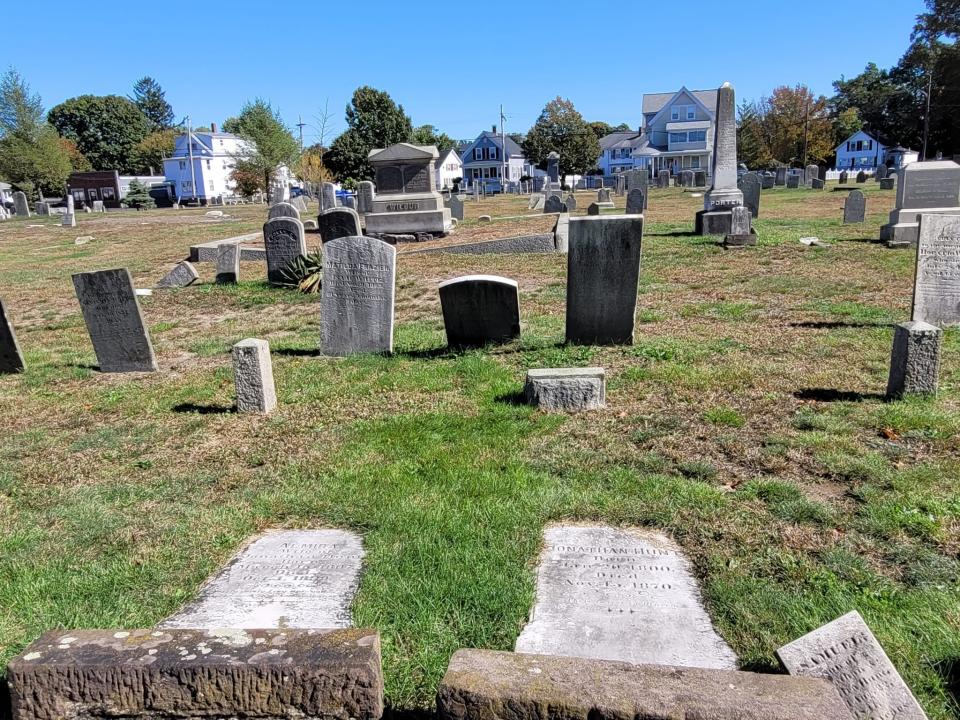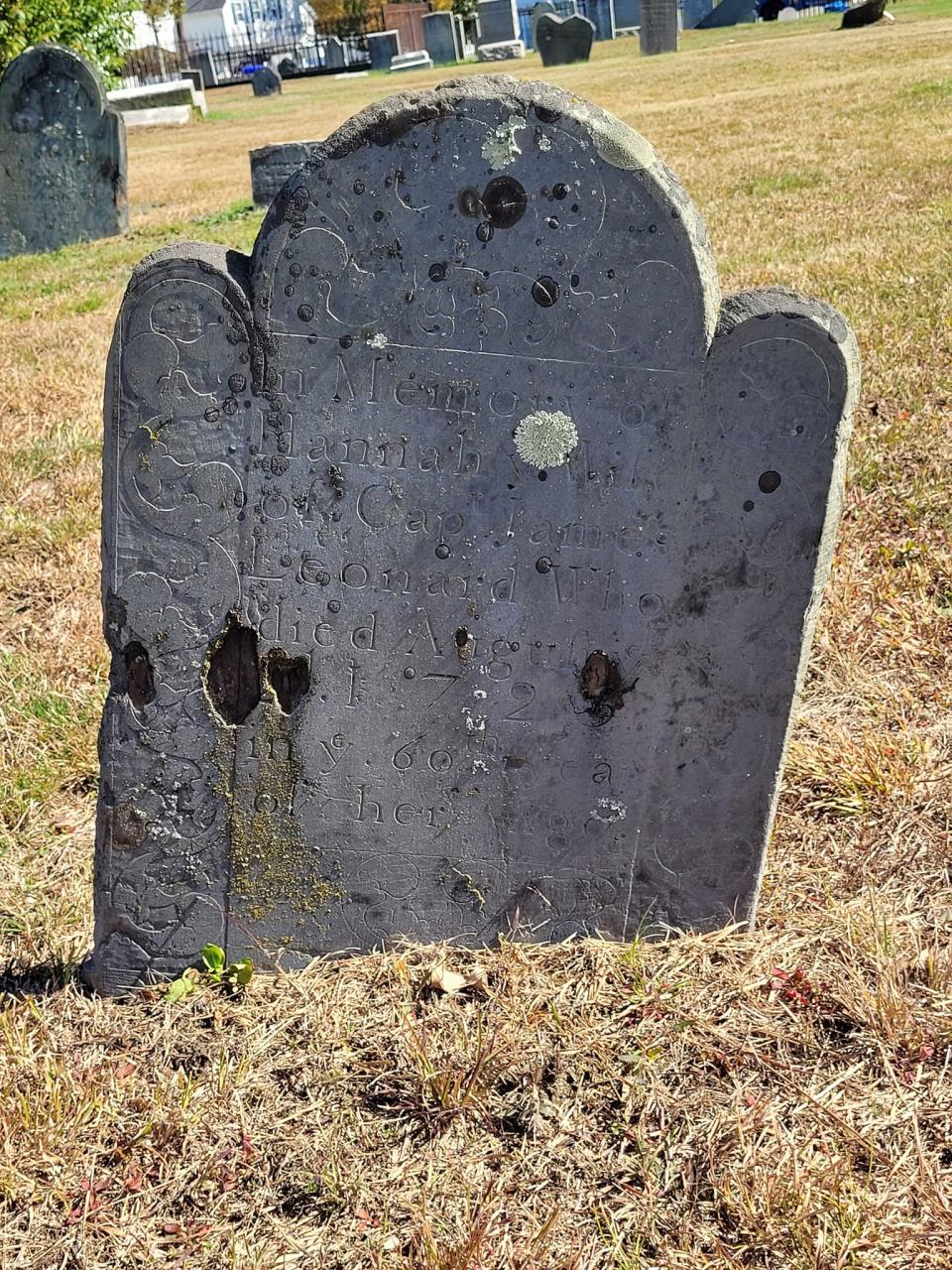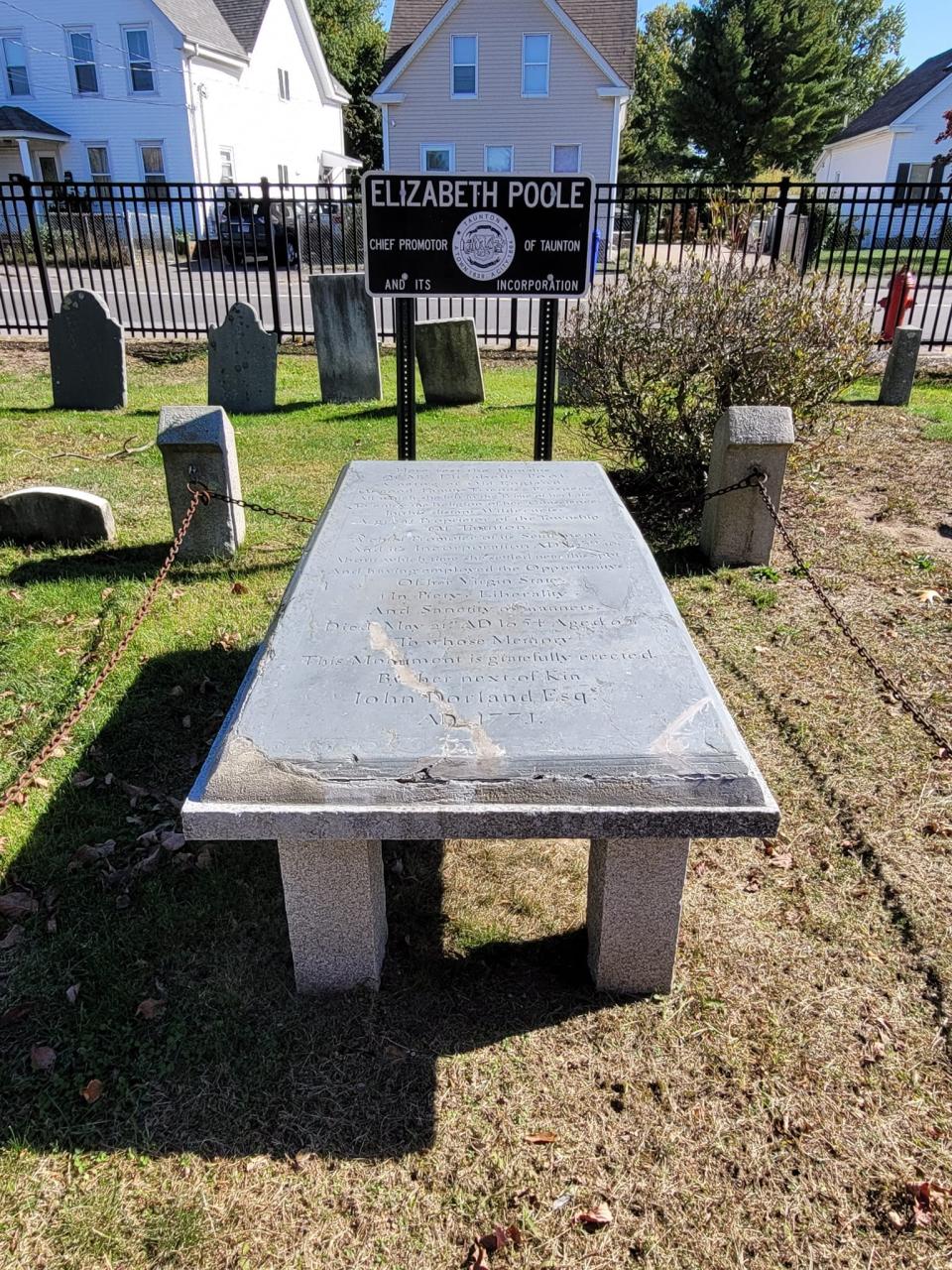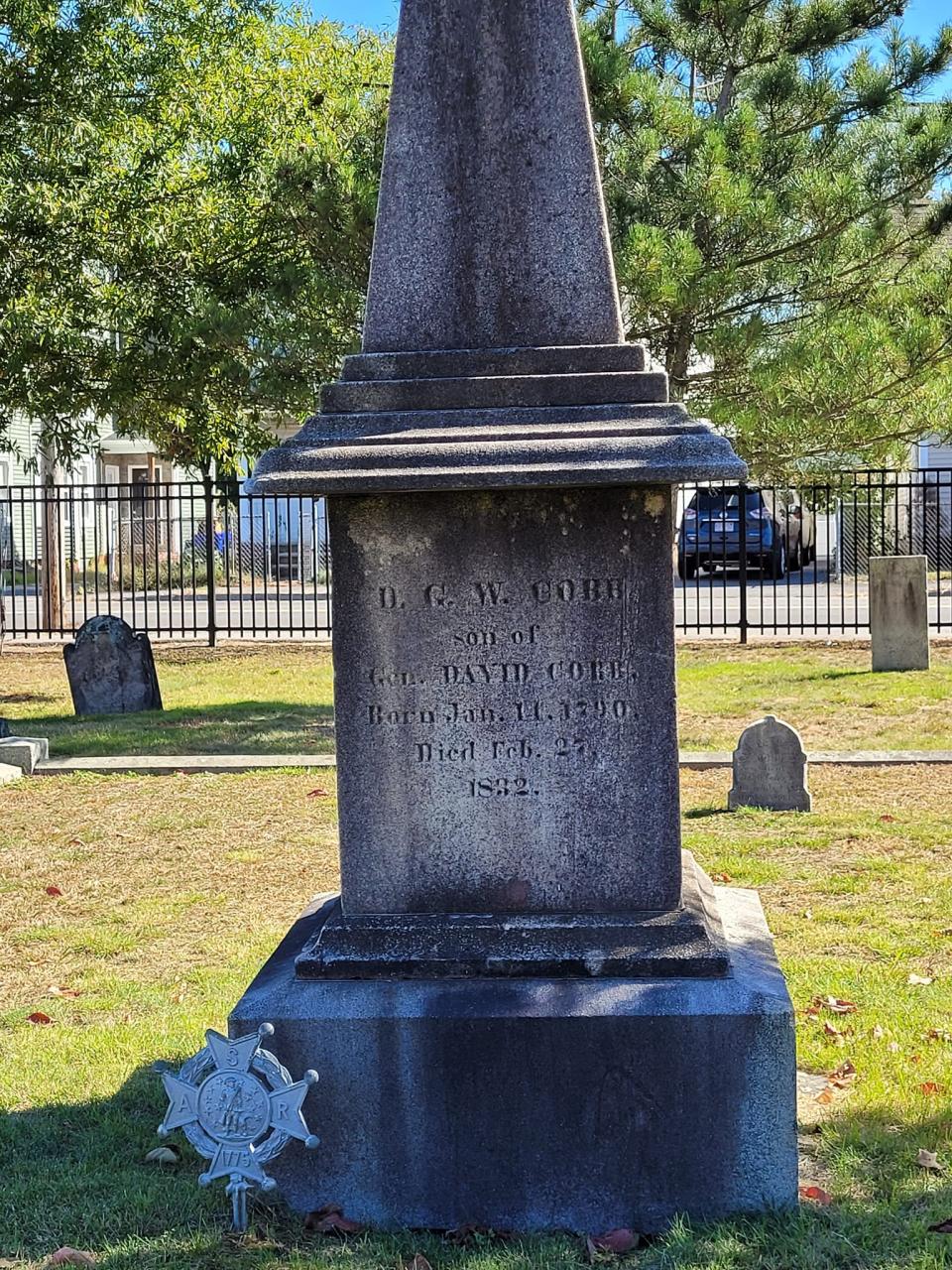'The blood be on your head': Taunton history etched into the gravestones at Plain Cemetery
TAUNTON — You’ve probably driven by it hundreds of times.
You’re cruising along Broadway, just past the little Cumberland Farms, and you might not even give it more than a cursory thought, the cemetery surrounded by fencing and a stone wall, that looks like it’s got some fairly old graves in it.
Maybe you know that some of the oldest graves in Taunton are there.
You might even know that Elizabeth Pole, one of the city’s earliest Colonial settlers, often thought of as the founder of Taunton, is buried there.
But when it comes to the history resting in the 10 acres of Plain Cemetery, that’s just the tip of the iceberg.
A brief history of Plain Cemetery
Once a part of the community’s common land, Plain Cemetery got its name because of the mostly flat land that makes up its grounds, according to a brochure for a walking tour of the graveyard, put together by the Old Colony History Museum.
OCHM offers a different cemetery tour each month, from May to October. These tours offer a history of the graveyard and are also often centered on a theme, for example, “industrialists buried at Mayflower Hill.” For more details and a full schedule of events, visit the museum’s Eventbrite page.

Plain Cemetery has also sometimes been called the “North Burying Ground.”
According to the OCHM brochure, it’s the second oldest municipal cemetery in Taunton (the first being Neck O’Land Cemetery on Summer Street).
The oldest recorded death date is Hannah Leonard, from 1725. On a recent visit, the most recent death date the Taunton Daily Gazette could find there was from 1972.

Although it was only formalized as a burial ground in 1748, the land for Plain Cemetery was given as a gift by the Rev. Samuel Danforth when he died in 1727. He was ordained in 1688 as the fourth minister of Taunton’s First Parish Congregational Church. His grave can be found in Section 59.
Danforth’s might have been the first original burial in Plain Cemetery, according to the OCHM brochure, but the oldest grave there is Leonard’s. She and 14 others were all brought there from other graveyards.
At least 31 victims: Serial killer Jane Toppan spent her final years at Taunton State Hospital
Originally, there was no charge for a cemetery lot, so no formal record exists of many of the burials until 1908, when the city’s parks department undertook plotting and recording gravestones. Today, the Old Colony History Museum has a file with the plots at Plain Cemetery, including an invaluable record of graves from before 1800 and the inscriptions on them, so many of which are no longer legible on the gravestones themselves, due to the ravages of time and weather.
In addition to the city, the Taunton Garden Club has also had a hand in taking care of Plain Cemetery over the years, including planting trees throughout the graveyard.
Historical figures buried at Plain Cemetery
The most famous local person buried at Plain Cemetery is Elizabeth Pole.
She was originally buried on what had been her property on Main Street. More than a century after her death, in 1771, an epigraph written by Robert Treat Paine was placed near where she was thought to be buried.
In 1792, according to “A History of Taunton Massachusetts” by William Hanna, her grave was discovered during some construction. Her remains were moved to Plain Cemetery, and today her grave is marked with the epigraph, as well as a large sign with her name on it. That is in Section 26.

Taunton’s first known murder victim, Elizabeth McKinstry, is also buried at Plain Cemetery. She was just 28 years old when she was killed on June 4, 1763, by an enslaved man named Bristol. According to an OCHM blog post by Hanna, Bristol confessed to the crime, but we may never know the truth of his motives: he told authorities another enslaved person threatened his safety if he did not do it. But no record exists of whether or not that person was held responsible. According to the blog post, and court records, Bristol hit her on the head with a piece of iron, then knocked her into the fireplace. After that, he hit her again and dragged her into the cellar, where he hit her on the back of the head with an ax, before he ran away. Bristol was found guilty of her murder and is said to have been hanged from a tree that once stood not far from her grave.
We don’t know much else about the crime. We know even less about Bristol, not even his real name. He was taken from Africa when he was a child, and was enslaved by the McKinstry family. He was defended in his trial by Robert Treat Paine.
The inscription on McKinstry’s stone, which has also been damaged by time and weather, reads “Watch for ye know not the manner nor the moment of your death.” She is buried in Section 53.
Another notable Tauntonian buried at Plain Cemetery is General David Cobb (1748-1830). He was a renowned veteran of the American Revolution, according to the OCHM brochure.
Cobb was chosen as a trusted aide to George Washington in 1781. He was made a general in 1783.

A doctor, he returned to his practice in 1784 and was soon awarded a judgeship in Taunton.
Local legend says that during Shay’s Rebellion (1786-87), “Judge Cobb played a dominant role in subduing the mob of farmers and soldiers on Taunton Green by using his sword to draw a line in the ground and proclaiming ‘Pass that line and I fire. The blood be on your head,’” according to the Plain Cemetery tour brochure.
Cobb, who also served in the state legislature and as lieutenant governor, is buried in Section 27.
Taunton-area housing market: Record hot real estate market near Taunton pushes Bristol County home sale prices to $460k
Notable burials in Plain Cemetery
Plain Cemetery, according to Find A Grave, is the final resting place of 42 Revolutionary War veterans and 53 Civil War veterans.
The Gazette also noticed headstones for veterans from the War of 1812.
Plain Cemetery has the graves of Tauntonians from all walks of life: the people there were mill workers, industrialists, clergy, doctors, nurses, immigrants, Mayflower descendants (so, really old immigrants), parents, spouses and children.
![This headstone is a testament to Elizabeth Briggs' 46 years of dedicated work at the Hopewell Mills. It reads in part: "This Tablet Commemorates The Diligence, Usefulness And Worth Of Miss Elizabeth T. Briggs, Who for Six and Forty years, [Let it be recorded as no common praise] Performed the duties Of a Weaver in the Hopewell Mills. .... She discharged Each duty with unremitting zeal And inviolate fidelity."](https://s.yimg.com/ny/api/res/1.2/IJnB9VhMk4d3kofRJ7XBVg--/YXBwaWQ9aGlnaGxhbmRlcjt3PTk2MDtoPTEyODA-/https://media.zenfs.com/en/taunton-daily-gazette/dc6f9e7dd28f8f7f46897fc4adfdf307)
There is so much local history to explore within the confines of Plain Cemetery, but here are just a few notable graves, listed in the archives at OCHM:
Ziba Babbitt: 1782-1834, Section 6, a veteran of the War of 1812.
Lulu Plant: 1863-99, Section 4, served in the Navy Nurse Corps during the Spanish-American War. Caught yellow fever in Cuba and died during her service.
Joseph E. Wibar: 1792-1881, Section 33. Prepared the landscape design for Mount Pleasant Cemetery.
Nicholas Crapo: 1809-81, Section 81. His contracting company built the Winthrop Street Baptist Church.
John Dawson: 1797-1829, Section 43. He was employed at the calico works. He fell to his death trying to unclog ice from a sluice; he was crushed by the water wheel. His grave tells some of the story of his gruesome end, and warns the reader as well to keep an eye over their own shoulder. He was a charter member of the Independent Order of Odd Fellows, and they were the ones who commissioned his gravestone.
Robert Crossman: 1709-99, Section 41. He was the famed furniture maker behind the blanket chests known as “Taunton chests,” of which fewer than 35 are known to survive. OCHM has two.
Samuel Crocker: 1772-1853, Section 41: Established with Charles Richmond the Hopewell Mill and Calico Print Works.
Elizabeth Briggs: 1803-84, Section 66. The inscription on her gravestone is a testament to her devotion to her work. It reads: “This tablet commemorates the diligence, usefulness, and worth of Miss Elizabeth T. Briggs, who for Six and Forty years, [Let it be recorded as no common praise] Performed the duties Of a Weaver in the Hopewell Mills. …. In an exemplary and humble walk of life She discharged Each duty with unremitting zeal And inviolate fidelity.”
Taunton Daily Gazette/Herald News copy editor and digital producer Kristina Fontes can be reached at kfontes@heraldnews.com. Support local journalism by purchasing a digital or print subscription to The Herald News and Taunton Daily Gazette today.
This article originally appeared on The Taunton Daily Gazette: Taunton Plain Cemetery: Elizabeth Pole, David Cobb buried off Broadway

